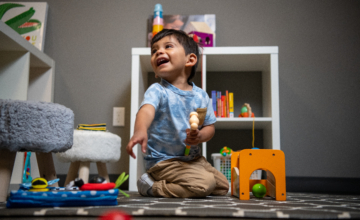The reauthorization of the Elementary and Secondary Education Act (ESEA) provides an opportunity to begin early in addressing the lagging literacy skills of students in the United States, through sound policy and practice.
Positive early language and literacy development can give children a window to the world, helping to ensure that each child can seize his or her potential for future success. During the first 3 years of life, the brain undergoes its most dramatic development and children acquire the ability to think, speak, learn, and reason. When this early development is not nurtured, the brain’s architecture is affected and young children begin to fall behind.
Many low-income children arrive at school already behind in communication and language, a disadvantage that only persists over time. Parents and early childhood professionals play a critical role in the development of a child’s early literacy skills. By supporting them in this role, we reap significant dividends throughout a child’s entire scholastic career.
At 16–18 months, when children begin amassing vocabulary, word learning is significantly affected by economic background.
The literacy gap hinders our nation’s ability to create the workforce needed to compete in the global market and ensure future prosperity. Sound policy should be grounded in the fact that young children’s language and literacy development begins long before they walk through the door of a kindergarten classroom. The reauthorization of the Elementary and Secondary Education Act (ESEA) provides an opportunity to begin early in addressing the lagging literacy skills of students in the United States, through sound policy and practice.
Policy Recommendations
As Congress and the Administration prepare for the reauthorization of ESEA and consider how to increase literacy skills and reduce the early achievement gap for all children, we urge attention to the earliest years, when the critical foundation for later learning is formed. Policies and legislation focused on literacy should:
1. Emphasize family engagement, particularly the role of parents in emergent literacy and the importance of reaching all at-risk infants and toddlers.
Policies should reflect the importance of educating parents to support their child’s development through family activities that promote a language- and literacy-rich home environment. Policies should also ensure the availability of family literacy services that support the literacy of parents as well as children.
2. Dedicate funding to support early language and literacy development in infants and toddlers, including professional development for early childhood professionals who care for infants and toddlers.
Early childhood professionals play a critical role in setting the stage for a young child’s future academic success. Because of the crucial need to ensure a firm foundation on which later skills will build as children prepare for and enter school, funds within early childhood allocations for literacy should be dedicated to high-quality early language and literacy training for professionals who care for infants and toddlers.
By age 3, trends in the amount of talk, vocabulary growth, and style of interaction are well established and suggest widening gaps.
3. Ensure that wording of literacy legislation for children birth through grade 12 reflects children’s needs across the entire age range.
The foundation of future academic success is laid during infancy and toddlerhood. To reinforce with states the need to include very young children in their literacy systems, legislation supporting literacy from birth through secondary school should recognize the continuum of literacy development that begins at birth and use terms appropriate for all age groups. This includes referring to language as well as literacy acquisition and development as well as early learning. It is also important to recognize that programs should target not only approaches for promoting literacy and education of students in school and prekindergarten, but should also include effective strategies to develop early childhood programs serving children from birth to age 3.
4. Build collaborations among birth to 3, prekindergarten, and K–12 programs to create shared responsibility for language and literacy development.
Families, caregivers, and educators must recognize the role each plays in supporting language and literacy development at every step from birth through secondary school. Children’s progress through this continuum can be strengthened and better scholastic outcomes produced if parents, early childhood professionals, and educators collaborate and understand how language and literacy are acquired and strengthened at different stages in a child’s development. This includes supporting children through transitions, sharing data, evaluating child progress over time, and building knowledge and skills in a community context across the range from birth to grade 12.
Gaps widen, rather than diminish, over the early elementary years.
5. Focus research funds on supporting early language and literacy for infants and toddlers.
Research must be expanded to explore the best approaches for supporting early language and literacy development, as well as for promoting the education of parents and early childhood professionals on how to optimally nurture this stage of development. In addition, assessments of childhood learning should focus not only on measures of what students have learned over time relative to academic standards, but also on how young children in early care and education settings have progressed over time relative to developmental norms.
Research
Literacy Emerges From Early Experiences
At its heart, literacy is about communication, which begins long before a baby utters her first word. Babies are prewired to learn, communicate, and connect with others; they tell us what they need through their cries, facial expressions, sounds, and movements. The growth and development of infants and toddlers are best supported not through a set curriculum, but rather through exploration, discovery, and the everyday activities in which they interact with adults around them.
A child can only achieve competency in essential school readiness skills—such as language and early literacy—when he has begun to experience and master all the domains of development. These include cognitive, social, emotional, and physical development, as well as noncognitive areas such as motivation to read and persistence in learning.
The learning that occurs within these developmental domains is fostered through the relationships that a young child has with the significant adults in her life. Families and other caregivers—such as early childhood professionals—are “the ‘active ingredients’ of environmental influence” during early childhood. The interactive nature of the relationship between a child and his caregivers is essential to the developing brain as it forms the complex web of visual, language, motor, and social-emotional connections necessary for later literacy learning. These positive relationships lead to trust, which then gives a child the resilience to face new challenges, actively explore, and focus on the task of learning.
Children’s academic successes at ages 9 and 10 can be attributed to the amount of talk they hear from birth through age 3.
Family Interactions Are a Key Component
Given the importance of parent–child relationships in nurturing early development, family literacy is a key factor and influence in a child’s early literacy experiences. A family’s literacy skills directly affect parents’ role and effectiveness in helping their children to learn. This is because families are often the first language teachers, determining their child’s actual language and style of dialect and establishing the rules for communication. In addition, when families share stories, songs, and books with their children, they not only model how their children develop literacy skills, but also give their children the message early on that learning to read and write is important.
Early Childhood Professionals Play a Key Role
Second only to the immediate family, child care is the context in which early childhood development most frequently unfolds, starting in infancy. As a result, early childhood professionals play a critical role in influencing the positive development of very young children. The quality of the child care setting and, perhaps more important, the relationships between children and early childhood professionals play crucial roles in language and literacy development. An environment where early childhood professionals are positive, supportive, and offer plentiful verbal stimulation is one where children are likely to show advanced cognitive and language development.
Early childhood professionals need to be knowledgeable and intentional in their support and nurturing of early literacy in infants and toddlers. They need to know how to foster children’s confidence as communicators, encourage and acknowledge children’s understanding of narrative and of themselves as “storytellers,” support the cultural contexts in which early literacy emerges, foster an appreciation of reading, and, above all, build the warm, supportive relationships that nurture a love of learning. It is important that the people who influence a child’s development—family, nonfamily caregivers, community members—are supported to provide a positive early learning experience for even the most at-risk children.
The Language Gap Begins Early
Research suggests that a young child’s ability to use language, as well as attune to and understand the meaning of spoken and written words, is related to later achievement in reading, writing, and spelling. Studies also show that children from low-income families are both spoken to and read to less frequently than their middle-class peers, which hinders their ability to develop literacy and language skills. This leads to the widening achievement gap or “language gap.” This gap among at-risk children of varying socioeconomic backgrounds emerges early and begins to widen long before their scholastic careers begin.
A seminal study by Betty Hart and Todd Risley soundly documented this gap. As illustrated in Figure 1 of the article linked on this page, simply in terms of the number of words heard, the average child of low socioeconomic status had half as much experience in hearing words as a child of middle socioeconomic status, and less than one third that of the average child of high socioeconomic status. More than any other factor, socioeconomic status made an overwhelming difference in how much talking occurred in a family. The type and frequency of language very young children hear in their homes, as well as parents’ use of positive or negative sounds, gestures, and words to communicate, contribute to the literacy disparities in households of varying socioeconomic status.




